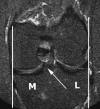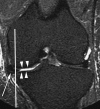Factors associated with meniscal extrusion in knees with or at risk for osteoarthritis: the Multicenter Osteoarthritis study
- PMID: 22653191
- PMCID: PMC3401352
- DOI: 10.1148/radiol.12110986
Factors associated with meniscal extrusion in knees with or at risk for osteoarthritis: the Multicenter Osteoarthritis study
Abstract
Purpose: To assess the associations of meniscal tears, knee mal-alignment, cartilage damage, knee effusion, and body mass index with meniscal extrusion.
Materials and methods: The Multicenter Osteoarthritis study is an observational study of individuals who have or are at risk for knee osteoarthritis (OA). The HIPAA-compliant protocol was approved by the institutional review boards of all participating centers, and written informed consent was obtained from all patients. All subjects with available baseline knee radiographs and magnetic resonance (MR) images were included. MR imaging assessment of meniscal morphologic characteristics, meniscal position, and cartilage morphologic characteristics with use of the Whole-Organ Magnetic Resonance Imaging Score system was performed by two musculoskeletal radiologists. Cross-sectional associations of severity of meniscal tears, knee malalignment, tibiofemoral cartilage damage, knee effusion, and body mass index with meniscal extrusion were assessed by using logistic regression, with multiadjustments when testing each predictor.
Results: A total of 1527 subjects (2131 knees; 2116 medial and 2106 lateral menisci) were included. Medially, meniscal tears, varus malalignment, and cartilage damage were associated with meniscal extrusion, with odds ratios (ORs) of 6.3 (95% confidence interval [CI]: 5.0, 8.0), 1.3 (95% CI: 1.1, 1.7), and 1.8 (95% CI: 1.4, 2.2), respectively. Laterally, meniscal tears, valgus malalignment, and cartilage damage were associated with meniscal extrusion, with ORs of 10.3 (95% CI: 7.1, 14.9), 2.2 (95% CI: 1.5, 3.2), and 2.0 (95% CI: 1.3, 2.9), respectively.
Conclusion: Meniscal tears are not the only factors associated with meniscal extrusion; other factors include knee malalignment and cartilage damage. Meniscal extrusion is probably an effect of the complex interactions among joint tissues and mechanical stresses involved in the OA process.
Figures


References
-
- Crema MD, Guermazi A, Li L, et al. The association of prevalent medial meniscal pathology with cartilage loss in the medial tibiofemoral compartment over a 2-year period. Osteoarthritis Cartilage 2010;18(3):336–343 - PubMed
-
- Hunter DJ, Zhang YQ, Niu JB, et al. The association of meniscal pathologic changes with cartilage loss in symptomatic knee osteoarthritis. Arthritis Rheum 2006;54(3):795–801 - PubMed
-
- Roos H, Laurén M, Adalberth T, Roos EM, Jonsson K, Lohmander LS. Knee osteoarthritis after meniscectomy: prevalence of radiographic changes after twenty-one years, compared with matched controls. Arthritis Rheum 1998;41(4):687–693 - PubMed
Publication types
MeSH terms
Grants and funding
LinkOut - more resources
Full Text Sources
Medical
Research Materials

